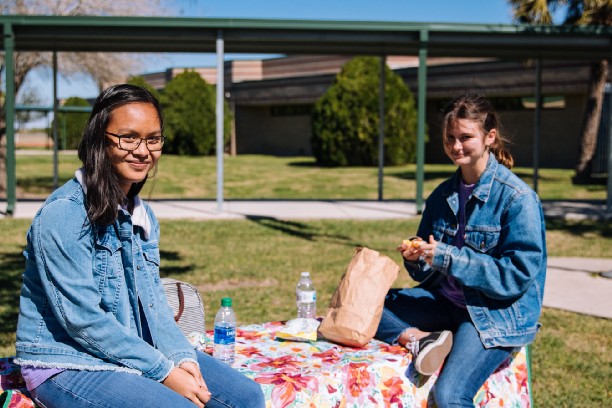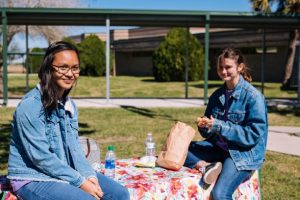“We need to rebuild our schools from the ground up with the democratic classroom in mind. This would increase the positive outcomes of education for everyone and create the world leaders that we need to solve global problems such as climate change” — High School student
I’ve been researching and teaching about student-centered education and intervention programs for over a decade. The research is clear – kids are more engaged in school when their education is personally meaningful and culturally relevant. Sure, some students do fine in a traditional school setting if the definition of success is high-scores on standardized tests and their ability to get into college. However, what is the price that many of them pay for this achievement?
Rates of anxiety and depression are skyrocketing in teens. In a 2018 study by Pew Research Center, seven out of 10 U.S. teens reported that anxiety and depression are significant problems in their community amongst people their age. Experts report that academic and social pressures contribute to depression and anxiety. We can only expect that between the pandemic, wildfires burning through much of the US, police brutality, and increasing division, young people are experiencing even more depression and anxiety in 2020. The young people who I talk with are sharing their concerns daily, and I can see it is taking a toll on them.
Schools can and should be a place where students feel supported and safe. However, far too many kids are marginalized by the school system, and “good grades” are not enough to prepare them for the challenges they will face today and as adults. To address these issues, many schools are starting to say they are student-centered, but it is rare in practice. As many schools move to online learning because of COVID-19, the desire to control students instead of partnering with them is blatant. Schools try to control what students wear, when they eat, and where and how they sit in their own homes. Teachers are expected to police children’s bodies remotely. In many of these situations, educators still claim to be student-centered or youth lead while giving students no voice in decisions affecting them.
I scoured the globe looking for an opportunity to be able to see proper student-centered education implemented. When I was offered a chance last year to teach at was promoted as a democratic learning environment, I jumped for it. The director enthusiastically stated the school was student-centered and that self-directed learning was supported by teachers who served as mentors. Within the first couple of weeks, I learned that the curriculum in most classes was set in stone, that staff did not understand what differentiated instruction was, and that students had limited or often no choice in what they studied or how they demonstrated their knowledge.
Additionally, punishment rather than positive behavior supports was standard practice. Students did not have a chance to make decisions about what affects them. For example, uniforms were mandatory and chosen by the director, students were not allowed to color their hair, and the bill of rights was given to them not created by them. When students voiced opposition, they were often told the decisions were already made and couldn’t be changed. In my classes, we discussed democratic education and watched videos of youth describing what it looks like when students create their own schools. Sometimes, I felt I was setting my students up for frustration by showing them what was possible while they were stuck in an oppressive environment.
I wish I could say that I was surprised by the contrast between how the school described itself and what actually transpired in the classroom. However, my experience at this school is not uncommon. I have observed in over 100 schools in different regions and have seen this dynamic play out in many of them. Unfortunately, “student-centered” and “self-directed” have become buzz words in the educational sector. It is easy to type them onto your website pages, but it takes courage to break out of the status quo and trust in youth to put these constructs into practice.
Schools often use the terms student-centered, self-directed, youth lead, and project-based learning to recruit students, placate parents, and promote a social justice image. Since my previous experience of feeling like I had been duped, I’ve been thinking a lot about why educators know these terms, and students strongly desire these types of learning environments, but schools still will not implement them. Although many factors come into play, three stand out — trust, control, and ego.
Trust: Unfortunately, in many years of doing observations of adult interactions with young people, it is clear that adults often do not trust kids. Some are outward in their distrust, and others are more subtle. I often hear statements like, “if we let kids do what they want, they would just play video games;” “kids just don’t have intrinsic motivation, they need deadlines;” “we have to make them do their work, they won’t do it on their own;” and “they don’t know what they need.”
True, kids LOVE video games, and that it isn’t a bad thing. If educators don’t use them as a tool for engagement, we are missing a huge opportunity to connect with our students. I admit I am not a fan of video games, and I have to check my biases; however, I am learning that there are many benefits of gaming, including improved memory, decision-making, and mental flexibility. I also had to admit that even the most ardent gamers will eventually want to do something else. So no, they won’t only play video games if we give them a choice in what they do with their day.
For example, one of my students who self-describes as a “gamer” expressed in an essay about how the democratic classroom helped him.
“You opened so many doors to me even when nobody else would care about me, like when you give me the due date extension for this essay. You gave me the opportunity to stay in the school for a good reason: you believed in my true potential and knew how to exploit it, so between this text and the final paper, you’ll notice that I tried to do well on both projects.” — High School student
Contrary to what some adults like the ones quoted above believe, intrinsic motivation cannot be built by force. If students are coerced into completing tasks by definition, the motivation is extrinsic, which we know can ultimately decrease intrinsic motivation. If students get through school because they are extrinsically motivated to do so, they are not building intrinsic motivation, which will serve them throughout their lives.
The student above who was not initially motivated to complete assignments became engaged when he felt heard and cared about. Educational research has been “proving” student-teacher relationships matter for decades. It is shocking to me that people still think that connecting with students and meeting them where they are is a radical approach. It is merely treating our students with the same level of interest, respect, and openness that we give to adults. In a democratic classroom, where we co-create rights and responsibilities, the authoritarian hierarchy dissipates, and trusting relationships form more easily.
Not trusting kids is harmful to them. An example of this is when adults say, “they don’t know what they need.” Being able to express our needs in a way that gets them met is essential to our well-being. If we tell children that they don’t know what they need and then tell them what their needs should be and dictate the response to the imposed needs — how are they supposed to learn to trust themselves and make decisions that promote health and wellness? If kids express their needs by saying things like “it makes me uncomfortable to have my camera on during PE,” or “I get really hungry during class,” and teachers tell them those needs are invalid, it damages student-teacher relationships. It can also make students reluctant to express their needs because teachers have demonstrated they will not listen to their requests anyway.
Additionally, we know that learning occurs after basic needs are met, so making students deny their needs is in direct conflict with trying to help them learn. It isn’t about their education. It is about control!
Control: Trying to control students and extrinsic rewards often go hand in hand. Teachers frequently offer rewards to force compliance, and kids may accept them to stay out of trouble. However, kids want freedom; they want to have a choice in what happens in their lives (as we all do). Schools spend an excessive amount of time trying to control students’ lives, including how they wear their hair, what classes they take, what time and where they can eat, and even when they can go to the bathroom. Almost daily, I see posts online about how this desire to control is seeping into students’ homes now that many schools are online.
“I want my school to start applying the concepts of a democratic classroom more because in my school many times there are unfair acts committed including in the decisions made.” — High School student
Not involving students in decisions that affect them sends the message that we don’t trust them to make choices about their lives.Yet when they leave the school system, we expect them to be fully capable of making big decisions after having so few opportunities to make small ones.This approach is in stark contradiction to everything we know about how to build self-determination, which requires that people feel competent, autonomous, and connected to those around them. The punitive measures often dished out by schools make students feel less competent, teachers not listening when students ask for what they need destroys connection. The oppressive structures rule out any chance of autonomy. Seriously, if you can’t even make decisions about things that impact you like whether or not to wear shoes in a Zoom meeting (yes, some schools are policing that), how are you ever going to learn to be autonomous?
A democratic education changes those dynamics, and students make decisions about things that impact them. They also understand how it will help them prepare for adulthood.
“I think this could make a big change in society because students would be more prepared to participate in democratic decisions and be more responsible citizens, while also improving their way of learning and making it equitable. This would be possible because students will be able to make proposals on how to make their learning better, and implement improvements, by taking into account everyone’s ideas” — High School student
It is hard for adults to let go of control. Many will justify why they need to hold on to it, saying things like “it is for the kids’ own good,” or “I survived, they will too.” Some of it is also because adults have internalized that conformity is best. Therefore, they are uncomfortable with kids who do not look or act like them and attempt to get them to “fall in line” (a line that the educator has constructed in their mind). Letting go of control also can be a hit on adults’ egos.
Ego: As educators, we went to school for a long time, and we often feel like we have to be the all-knowing experts in the classroom. Some adults believe their many years of experience are more valuable than the lived experience of kids and that the kids couldn’t possibly bring new or useful information to the table. While adults can bring our expertise and knowledge to the classroom, letting go of the need to know everything and always be in charge is liberating. When we are vulnerable in the classroom, it allows space for kids to be vulnerable too. The more students feel they can take risks in the school, the more they will learn.
Often, kids shut down and don’t produce content because they fear “doing it wrong.” When teachers are willing to make mistakes, admit that there are things they don’t know, and model how to find solutions, they create an environment where kids can be ok with not knowing as well. Teaching in a democratic classroom where students chose what they want to learn can be humbling. It makes us aware that there is a whole lot that we don’t know.
While it is humbling, it can also be exciting because you get to learn alongside your students. And isn’t your love of learning one of the reasons you became an educator?
If you would like more information about how your school or classroom can become more democratic, check out these great resources:
* The Democratic Classroom Theory to Inform Practice by Art Pearl &Tony Knight
* The Pearl Remote Democratic School Youtube Channel





